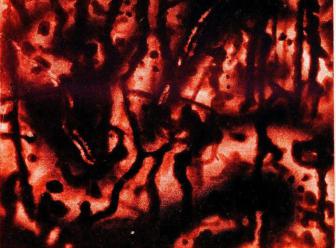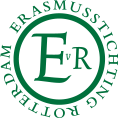Article
expelled from the corridors of power
An “intuitive” mystic

July 12, 2017
A: I truly never asked myself this question. For me, [my interest in Kabbalah] didn’t emerge from [theoretical] feminism, but instead [directly] from a woman’s connection to her body. The [concept of the Jewish mystical spirit] the Shekinah is after all feminine. Everything comes from the womb. Mysticism is connected to the body. The Ramban [a 12th-13th century Catalan rabbi and leading scholar] understood this, in his book, The Way of Truth, and the Rambam [another 12th century rabbi and leading scholar] was also a great mystic in my eyes. They didn’t present this material to everyone because they were afraid. But they knew what a woman was. They could not write about the significance of intercourse without having the profound experience of an orgasm that lifted them to the heights.
Q: Who, the male Kabbalists?
A: Yes, of course.
In addition to being a writer, Esther is an artist whose work is displayed in numerous exhibitions. In 2008 she was invited to present her work to the then-director of the Tel Aviv Museum, Moti Omer. The encounter soon turned traumatic. She felt that Omer was openly disparaging of her and her art.
“I don’t know what came over him,” she said. “Perhaps he was having a bad day. He belittled me, was very tough on me. I left there for the beach in Jaffa, and wrote and wrote, the papers blowing all around into the sea. I felt like throwing them away, but I didn’t. Later, when I was in residence at Oxford, I looked over these pages and felt that something lovely had emerged.”
The pages she wrote on the beach turned into the long poem “The cry of beauty,” which was published as a book by Carmel Press.
In the poem she likens Moti Omer to a being composed of thorns made “of meager material”. It begins, “I faced a castle closed tight/ a tower of weak-brained prejudice/ impossible to break through the deep gate of absence and narrow minds/ because the man at the top is a spiritual dwarf/ his standards/ who knows what they are?” In another line she writes, “It takes a high-powered microscope to see your soul/ and when you are gone…art will be redeemed”.
[Noted Israeli art critic] Gideon Efrat has written about this poem that it is “a document that every young artist and curator must experience, to give serious consideration to the ethos of artist-curator relations.” In his blog, Efrat wrote, “Such harsh words, such hostility, are not to be found in the history of Israeli art. I read this poem and I’m shocked at the vehemence of insult and the emotional numbness in the museum director’s approach to the artist … in an encounter of this type. Alternatively, I get the weight of the anger and hatred of rejected artists that a curator of Omer’s standing had to bear. I feel I must give it a platform. This is food for thought for many of us, curators and artists.”
The possibility of exhibiting at the Tel Aviv Museum attracted Esther, but, she says, publicity is not the main thing. She is also not disturbed by the number of people who will read her books. “I have regular readers…The Rambam said that he wrote his book, Guide for the Perplexed, for a single reader. If such a great man can write for one person, who am I to complain?”
Q: Weren’t you afraid to write so daringly while you still lived in the Haredi world?
A: What could they do to me? They couldn’t stomach me so they fired me from my job. I was teaching at a girls’ school. When Soft Stones [a work of prose] was published, the principal called me in and said, “This isn’t for us. Either give up art or stop working here.” They fired me, so what? I had a small pension and was happy. When a person knows what she wants to do in the world it’s a great gift.
Q: All the well-known Jewish mystics were men. There is no tradition of women Kabbalists.A: I truly never asked myself this question. For me, [my interest in Kabbalah] didn’t emerge from [theoretical] feminism, but instead [directly] from a woman’s connection to her body. The [concept of the Jewish mystical spirit] the Shekinah is after all feminine. Everything comes from the womb. Mysticism is connected to the body. The Ramban [a 12th-13th century Catalan rabbi and leading scholar] understood this, in his book, The Way of Truth, and the Rambam [another 12th century rabbi and leading scholar] was also a great mystic in my eyes. They didn’t present this material to everyone because they were afraid. But they knew what a woman was. They could not write about the significance of intercourse without having the profound experience of an orgasm that lifted them to the heights.
Q: Who, the male Kabbalists?
A: Yes, of course.
In addition to being a writer, Esther is an artist whose work is displayed in numerous exhibitions. In 2008 she was invited to present her work to the then-director of the Tel Aviv Museum, Moti Omer. The encounter soon turned traumatic. She felt that Omer was openly disparaging of her and her art.
“I don’t know what came over him,” she said. “Perhaps he was having a bad day. He belittled me, was very tough on me. I left there for the beach in Jaffa, and wrote and wrote, the papers blowing all around into the sea. I felt like throwing them away, but I didn’t. Later, when I was in residence at Oxford, I looked over these pages and felt that something lovely had emerged.”
The pages she wrote on the beach turned into the long poem “The cry of beauty,” which was published as a book by Carmel Press.
In the poem she likens Moti Omer to a being composed of thorns made “of meager material”. It begins, “I faced a castle closed tight/ a tower of weak-brained prejudice/ impossible to break through the deep gate of absence and narrow minds/ because the man at the top is a spiritual dwarf/ his standards/ who knows what they are?” In another line she writes, “It takes a high-powered microscope to see your soul/ and when you are gone…art will be redeemed”.
[Noted Israeli art critic] Gideon Efrat has written about this poem that it is “a document that every young artist and curator must experience, to give serious consideration to the ethos of artist-curator relations.” In his blog, Efrat wrote, “Such harsh words, such hostility, are not to be found in the history of Israeli art. I read this poem and I’m shocked at the vehemence of insult and the emotional numbness in the museum director’s approach to the artist … in an encounter of this type. Alternatively, I get the weight of the anger and hatred of rejected artists that a curator of Omer’s standing had to bear. I feel I must give it a platform. This is food for thought for many of us, curators and artists.”
The possibility of exhibiting at the Tel Aviv Museum attracted Esther, but, she says, publicity is not the main thing. She is also not disturbed by the number of people who will read her books. “I have regular readers…The Rambam said that he wrote his book, Guide for the Perplexed, for a single reader. If such a great man can write for one person, who am I to complain?”
© Eli Eliahu
Translator: Lisa Katz
Source: Excerpted from Haaretz 25 October 2016
Sponsors
























